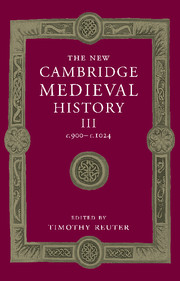Book contents
- Frontmatter
- 1 Introduction: reading the tenth century
- PART I GENERAL THEMES
- PART II POST-CAROLINGIAN EUROPE
- PART III NON-CAROLINGIAN EUROPE
- 19 European Russia, c. 500–c. 1050
- 20 Bohemia and Poland: two examples of successful western Slavonic state-formation
- 21 Hungary
- 22 Byzantium in equilibrium, 886–944
- 23 Bulgaria: the other Balkan ‘empire’
- 24 Byzantium expanding, 944–1025
- 25 Byzantium and the West
- 26 Southern Italy in the tenth century
- 27 Sicily and al-Andalus under Muslim rule
- 28 The Spanish kingdoms
- Appendix genealogical tables
- List of primary sources
- Bibliography of secondary works arranged by chapter
- Index
- Frontispiece
- Plate section
- Map 2: Archbishoprics and bishoprics in the early eleventh century
- Map 4: Germany
- Map 13: Byzantium in 1025
- References
25 - Byzantium and the West
from PART III - NON-CAROLINGIAN EUROPE
Published online by Cambridge University Press: 28 March 2008
- Frontmatter
- 1 Introduction: reading the tenth century
- PART I GENERAL THEMES
- PART II POST-CAROLINGIAN EUROPE
- PART III NON-CAROLINGIAN EUROPE
- 19 European Russia, c. 500–c. 1050
- 20 Bohemia and Poland: two examples of successful western Slavonic state-formation
- 21 Hungary
- 22 Byzantium in equilibrium, 886–944
- 23 Bulgaria: the other Balkan ‘empire’
- 24 Byzantium expanding, 944–1025
- 25 Byzantium and the West
- 26 Southern Italy in the tenth century
- 27 Sicily and al-Andalus under Muslim rule
- 28 The Spanish kingdoms
- Appendix genealogical tables
- List of primary sources
- Bibliography of secondary works arranged by chapter
- Index
- Frontispiece
- Plate section
- Map 2: Archbishoprics and bishoprics in the early eleventh century
- Map 4: Germany
- Map 13: Byzantium in 1025
- References
Summary
byzantine links with the western christians, 900–950
Byzantium’s relations with the Latin west in this period have a ‘Cheshire cat’ character in comparison with ninth-century exchanges. Very little attention is paid to the Christian west by Byzantine writers even when Saxon potentates begin to intervene in Italy and bedeck themselves with imperial trimmings. A memorandum of diplomatic procedures, compiled partly from older materials in the mid-tenth century, lists the standard form of address for letters to various reges, of ‘Gaul’ as well as Bavaria and Saxony: each is to be addressed as ‘spiritual brother’, unlike the numerous other addressees. But the protocols for receptions of ambassadors make no special provision for western ones: formulaic greetings for envoys from the Bulgarians and eastern Muslims are rehearsed, presumably because their visits were more important or frequent.
A somewhat later compilation would probably have paid western ambassadors little more attention than the Book of Ceremonies did on the eve of the imperial coronation of Otto I. For Basil II, as for his predecessors, the existence of a rival Bulgarian basileus was far more important. But if events beyond the Adriatic were generally of secondary importance to Byzantium’s rulers, the very powers which troubled them in the Balkans or hindered communications with the west obliged them to maintain outlying bases from which to disrupt their activities. Byzantine claims in Italy were based on quite recent military actions and not merely on the inheritance of the old Roman empire. The De administrando imperio recognises the territorial losses to the Lombards, but stresses the help which Basil I had provided against the Arabs, and claims authority over Capua and Benevento on the basis of ‘this great benefit rendered to them’ then.
Keywords
- Type
- Chapter
- Information
- The New Cambridge Medieval History , pp. 605 - 623Publisher: Cambridge University PressPrint publication year: 2000

